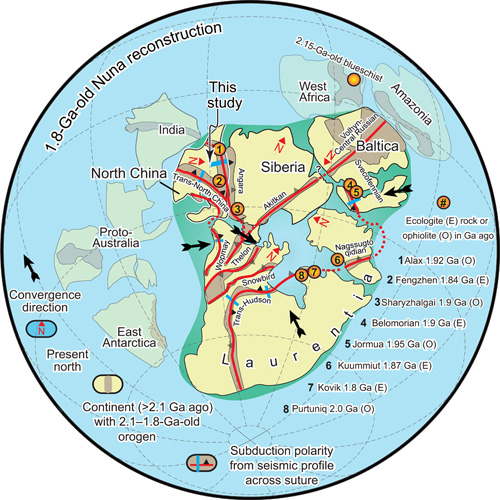20 April 2021–Seismic profiling of a very stable and ancient continental block in North China may offer clues as to when the Earth’s global subduction network began operating, according to a presentation at the Seismological Society of America (SSA)’s 2021 Annual Meeting.

Credit: Wan et al. (2020) Sci Advances
Seismic receiver function studies in part of the Ordos block revealed a feature called a “dipping Moho,” where the bottom of Earth’s crust bends sharply downward toward the mantle. The feature, in rocks dated to roughly 1.8 billion years old, indicates a collision between tectonic plates, said Xusong Yang of the Chinese Academy of Sciences.
Yang and colleagues have also collected seismic evidence of dipping Moho structures of about the same age from six continents. Together, the evidence suggests that subduction on a global scale may have begun around 2 billion years ago, and that these tectonic collisions formed the ancient supercontinent Nuna.
Its age, along with its extremely stable characteristics, make the Ordos block is a good place to look for evidence of earliest subduction, said Yang. Geological and geochemical evidence suggest that the North China craton, which contains the Ordos block, collided with Siberia 2 billion years ago, during a time of massive global mountain building called the Orosirian period.
At the same time, seismic studies shows that the rock layers inside the Ordos, dating from about 1.6 billion to about 66 million years ago, “are relatively undisturbed,” Yang explained. “Thus, the signs for the Orosirian subduction are very likely to be preserved in the Ordos block.”
“Various seismological methods can obtain clear images of subsurface structures, but the biggest difficulty is how to determine the age of the observed underground structure,” he added. “Thus, the seismic work must be combined with corresponding age data of geological or geochemical work before it can be used to study the earliest subduction. If certain areas are reworked by later tectonic events, the situation will be even worse.”
To detect signs of early subduction, the researchers in 2019 deployed a seismic array of 609 stations along a 300-kilometer line on the Ordos block. From earthquake data collected by this array, Yang and colleagues reconstructed a detailed picture of the deep crust in the region that revealed the dipping Moho. The structure looks very similar to the dipping structure found under the Himalayan mountains today, said Yang.
After reviewing studies showing dipping Moho structures of the same age from around the world, the researchers used the data to piece together a reconstruction of the supercontinent Nuna. If Nuna is the world’s earliest supercontinent, as many think, the collisions that brought it together could mark the start of global plate tectonics.
Yang said temperature changes of the Earth may have been the driving force behind the start of global subduction. As heat from the mantle dissipated in the early Earth, the ocean floods began to deepen around 2.8 to 1.7 billion years ago. “Perhaps it was around 2 billion years ago, as the ocean floor began to deepen with age, that made subductions easier on a global scale,” Yang suggested.
